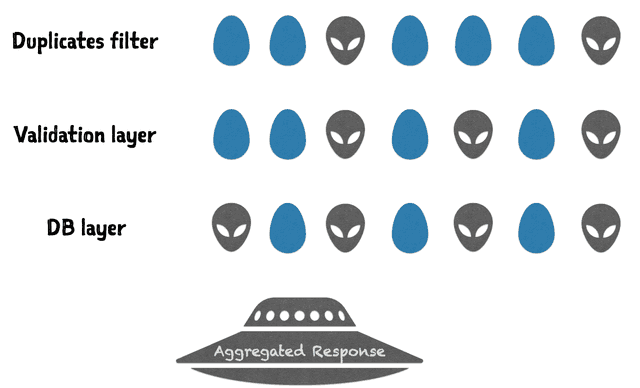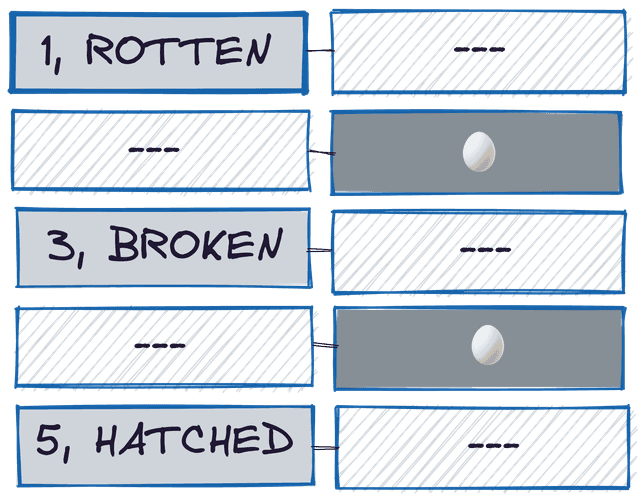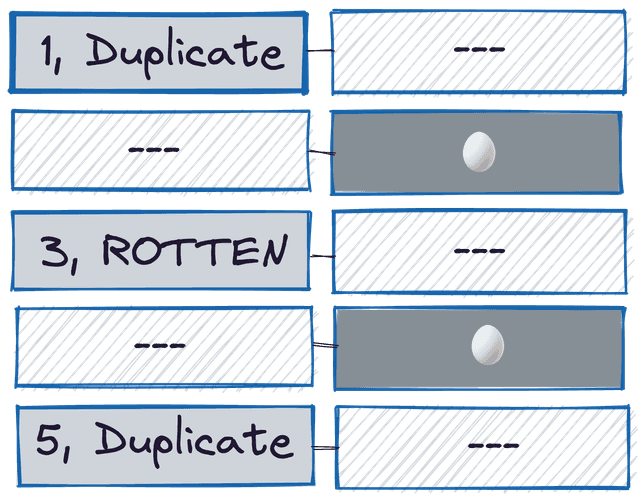Huh?🤔 to Aha!😇 - A Refactoring Story
Abstract
As a Dev, I need to Refactor, to make the codebase Refactorable. Refactorability, as defined by Martin Fowler is, “The ability to alter internal structure without changing its external behavior”. This applies to each atomic component of an app. Let’s achieve our dev story through a unique, yet the most effective method, Component Isolation.
Let’s huddle over persuasive arguments against Obstacles that hinder our goal causing entanglements among components, and Metrics that measure our success.
Let’s refactor a real-world app and witness how Isolated components make up long-lasting structures.
Audience
This applies to software developers at all levels. I use Java to demonstrate the code snippets, but this talk is about Software Design and is agnostic of programming language.
Takeaways
- How Isolated components can make up long-lasting structures and keep the rate of entropy growth in check.
- How to use MOM process (Methods, Obstacles, and Metrics), to build a case for your Refactoring story and pitch it to your team and Manager for funding.
- How Exceptions and Mutation hinder refactoring goals.
- How to eliminate Exceptions from your code using ADTs (Algebraic Data Types).
- How to replace Shared Global Mutable state on your Shared Codebase with Immutability and Data Transformations.
- A demo of a real-world app with these problems and how applying these simple methods can change the face of this service, thereby reducing the cognitive complexity and organically boosting the testability.
- Metric-driven approach to objectively realize the results and improvements achieved.
Talk Outline
Let’s check out the definition](https://refactoring.com/) from the person who authored an entire book about it.
Refactoring is a disciplined technique for restructuring an existing body of code, altering its internal structure without changing its external behavior
- This definition not only applies to your end-to-end application but also applies to each atomic unit that makes it up.
- Refactoring is not just restructuring the existing design or moving lines around with IDE shortcuts.
- Each component should be independent and loosely coupled, such that you should be able to change its internals without affecting the external behavior, which implies not affecting any of its dependent components.
That brings us to the story of our talk.
Goal 🎯
- As a Dev, I need to Refactor, to make the codebase Refactorable (That’s a recursion!)
- Refactoring is not a one-time activity. And every time you refactor or add a new feature, it’s your responsibility to leave the codebase in a state such that it’s Refactorable.
- This is just an agile way to say I want to build my components like Lego pieces, Components that can be reused, replaced, and most importantly Composed to form different structures.
Let’s follow the MOM process to manage our goal. Believe me, Managers love it when you do talk to them in their language. There are high chances they fund your refactoring in the same release!
Methods 🛠
We shall only focus on a couple of important Methods to achieve our goal:
-
Human Readability
- Refactoring is for humans, machines can run any shitty code.
-
Component Isolation
- How independent and loosely coupled my components are?
- Are the effects of my component reaching farther than they should?
Obstacles 🧗🏼
And a couple of major Obstacles that sabotage those:
- First up, we shall start with the most abused language feature, any guesses? - Exceptions and see how they bind a function to an entire call stack.
- Next, something that creates an even more invisible and unholy coupling - Mutability
Metrics 📐
And the Metrics to keep a check on our goals:
- Cognitive Complexity - which is inversely proportional to Readability
- Testability - Indicates how isolated your components are, to be composed and reused.
We shall apply those methods to a real-world** application** and realize how its metrics are affected.
Let’s start with Obstacles and how to overcome them:
Throw away Exceptions 👽
Mutation is Unholy 👹
Hello-real-world 🪐
Let’s see how some of what we talked about fits into a Real-world application
The Flow
- Assume this is a backend service for a Batch API, which gets a list of JSON.
- The request is unmarshalled into POJOs, which are filtered and validated in multiple layers.
- Based on the results, we build a batch response to send back in the end.
Partial Failures
- But the catch is, we need a way to handle partial failures. A batch API must hold on to all those failures till the end and skip them from getting processed further down so that we can send an aggregated response in the end.
- We are not interested in the failed ones, but in the reasons why they failed, which is a different data type
Failure. - The inability to pass and return results of two data types (
FailuresandEgg), and to handle partial failures, the first default choice was to use aHashMap, which is passed in and out of each step in the flow.
void filterDuplicates(Map<ID, Failure> failureMap,
List<Egg> eggsFromRequest) {...}
void validate(Map<ID, Failure> failureMap,
List<Egg> nonDuplicateEggs) {...}
List<EggEntity> toEntityObjs(List<Egg> validEggs) {...}
void bulkInsertIntoDB(List<EggEntity> eggEntityObjs)
throws DMLOperationException {...}- It is also used to filter valids from Invalids after each step.
filterDuplicates(failureMap, eggsFromRequest);
// Partitionvar nonDuplicateEggs = new ArrayList<Egg>();for (Egg egg : eggsFromRequest) { if (!failureMap.containsKey(egg.getId())) { nonDuplicateEggs.add(egg); }}
validate(failureMap, nonDuplicateEggs);
...
// Partition
...
var eggEntityObjs = toEntityObjs(validEggs);
try {
bulkInsertIntoDB(eggEntityObjs);
} catch (DMLOperationException ex) {
handlePartialFailures(failureMap, ex);
}
// Prepare response from `failureMap` and db insertion `results`This flow has all the problems we discussed before. Let’s apply our methods and see how this can be Refactored into.
The Signature Shift
We can use Either to represent the partial failures. This eliminates the need for a temporary data structure like HashMap, coz now both Valids and Failures can share the same List
// Before
void filterDuplicates(Map<ID, Failure> failureMap,
List<Egg> eggsFromRequest) {...}
// After
static List<Either<Tuple2<ID, Failure>, ImmutableEgg>> filterDuplicates(
final List<ImmutableEgg> eggsFromRequest) {...}- This is how a
List<Either<Tuple2<ID, Failure>, ImmutableEgg>>can be visualized.
- Either is switched from
righttoleftstate if it fails downstream.
- This also avoids the need for intermediate filtering between steps, coz all the failures contained in
Either.leftare auto-skipped from processing downstream. This is possible due to the **Monad** property ofEither`.
static Either<Tuple2<ID, Failure>, ImmutableEgg> validate(
Either<Tuple2<ID, Failure>, ImmutableEgg> eggToValidate) {
return eggToValidate // No validations execute if egg is Either.left
.flatMap(validateAge)
.flatMap(validateField1)
...
...
;
}Monad is out of scope to be covered here, but I have an entire 1 hour talk about this, which can help you fill in this missing piece:
Refactored into Isolated Pieces 🏝
This is how we refactored these components into isolated pieces.
// void filterDuplicates(Map<ID, Failure> failureMap,
// List<Egg> eggsFromRequest) {...}
static List<Either<Tuple2<ID, Failure>, ImmutableEgg>> filterDuplicates(
final List<ImmutableEgg> eggsFromRequest) {...}
// void validate(Map<ID, Failure> failureMap,
// List<Egg> nonDuplicateEggs) {...}
static Either<Tuple2<ID, Failure>, ImmutableEgg> validate(
final Either<Tuple2<ID, Failure>, ImmutableEgg> egg) {...}
// List<EggEntity> toEntityObjs(List<Egg> validEggs) {...}
static Either<Tuple2<ID, Failure>, EggEntity> toEntityObj(
final Either<Tuple2<ID, Failure>, ImmutableEgg> egg) {...}
// Partition
// void bulkInsertIntoDB(List<EggEntity> eggEntityObjs)
// throws DMLOperationException {...}
static Either<DMLOperationException, List<EggEntity>> bulkInsertIntoDB(
final List<EggEntity> eggEntityObjs) {...}But most importantly, they fit into each other, resembling a math derivation.
Let’s play some Lego
All these isolated pieces elegantly fit together, like Lego, groove-to-groove.
final var partition = filterDuplicates(immutableEggsFromRequest).stream()
.map(EggService::validate)
.map(EggService::toEntityObj)
.collect(Collectors.partitioningBy(Either::isRight));
final var objsToInsert =
partition.get(true).stream().map(Either::get).toList();
final var results = bulkInsertIntoDB(objsToInsert);
// Prepare response from `partition.get(false)` and `results`Metrics
How are we doing on our Goal! let’s ask our Metrics:
Cognitive Complexity
I don’t need any metrics to say that the refactored code is more readable. But for a few, that might not be the case. I heard some say this is more “Complex”. Complexity is a wide word thrown around loosely. Before labeling something complex, we need to be clear to ourselves, as well as others about what is Complex.
Complexity has different types:
- Accidental Complexity
- Essential complexity
- Cognitive/Cyclomatic complexity
It has Different layers too:
- Unfamiliarity vs Unreadability.
- Strict vs Non-extensible.
The refactored code may feel complex because:
- Essential Complexity - Due to all filtering, validations, and handling partial failures.
- Unfamiliar - Not everyone might have got a chance to work with Java 8 syntax, or they haven’t heard of
Eitherbefore. - Strict - We intentionally induced this strictness. Unlike earlier implementations where the Developer can imperatively mutate stuff, now he is no more is in control. Declarative transformations already paved lanes to drive with discipline leaving him partial control and no shortcuts. For someone who is conditioned to Mutation, it feels like “Coding with handcuffs”.
That said Cognitive Complexity can be Objectively measured using tools like SonarQube™.
-
My previous talks, on the usage of SonarQube™:
Testability
If you followed the methods we discussed, you get Testability for free. Well, most of it. There are just few more that you can follow to boost it further.
Separate Static from Signal
Take the example of this simple function, which maps the request object to the entity object.
// * EggEntity is a legacy class and cannot be instantiated with `new`
void fillEntityObj(Egg egg, EggEntity eggEntity) {
if (egg.field1() != null) {
eggEntity.put(Fields.field1, egg.field1());
}
if (egg.field2() != null) {
eggEntity.put(Fields.field2, egg.field2());
}
if (egg.field3() != null) {
eggEntity.put(Fields.field3, egg.field3());
}
}How do you unit test all these branches? Also, because the EggEntity can’t be instantiated in a unit test context, we tend to write a test like this:
@Test
void fillEntityObjTest() {
// * `EggEntity` Object can't be instantiated in a JUnit context.
final var mockEggEntity = mock(EggEntity.class);
var egg = new Egg("field1Value", null, "field3Value");
fillEntityObj(egg, mockEggEntity);
verify(mockEggEntity).put(Fields.field1,"field1Value");
verify(mockEggEntity, never()).put(Fields.field2, null);
verify(mockEggEntity).put(Fields.field3,"field3Value");
}A Brittle Test
-
This test is Brittle, because:
Unit Test !== Test InternalsUnit Test === E2E test for Unit.
-
Unit tests don’t mean testing the internals. It’s an E2E test for your Unit/Component.
-
You should respect the encapsulation of each unit/component you test and operate on an abstraction one level above.
-
Your test should be like an idiotic bot that fires your function with input and asserts the output. It’s not supposed to know anything else about your component code.
-
If it’s asking for internals, it gets tightly latched with your component, which tends to fail every time you refactor. Such tests instead of helping, act as a foot-chain for refactoring.
Make code Testable
The solution is not to write better tests but make the main code Testable. Let’s see our method closely, you can observe Static mixed with Signal:
- **Static:** 1-1 field mapping between `Egg` to `EggEntity`
- **Signal:** For each field mapping, fill non-null `Egg` fields into `EggEntity` using `put`.Let’s do the same in code:
<string, function<immutableegg,="" string="">> fieldMapping = Map.of(
Fields.field1, ImmutableEgg::field1,
Fields.field2, ImmutableEgg::field2,
Fields.field3, ImmutableEgg::field3);</string,>
// Call with Static data and Function reference fillEntityObj(egg, fieldMapping, EggEntity::put);
// Signal static void fillEntityObj( ImmutableEgg egg, Map
<string, function<immutableegg,="" string="">> fieldMapping
BiConsumer<string, string=""> filler) {
fieldMapping.forEach((fieldId, valueGetter) -> {
final var fieldValue = valueGetter.apply(egg); if (fieldValue != null) {
filler.accept(fieldId, fieldValue);
}
});
}</string,></string,>
- Now, We can focus on testing just the signal part.
- This BiConsumer is agnostic of what’s passed, so we can cleverly use a
HashMap::putto test this function. - As our code turns testable, we don’t need magical mocking frameworks or over-granular testing to achieve ~95% test coverage. We can easily write highly targeted tests.
DI
Unit tests hate side-effects. All your objects used to perform side-effects should be declared as constructor dependencies or method params, so you can stub them for unit tests. Something like this:
@Autowired
public EggService(
...,
@Qualifier(EGG_REPO) EggRepo eggRepo,
...
)But if all you need is a function from a Dependency, resist injecting the entire object. Instead, inject only the function that you need.
@Autowired
public EggService(
...,
// @Qualifier(EGG_REPO) // EggRepo eggRepo,
@Qualifier(EGG_INSERTER) Function<EggEntity, ID> dbInserter,
...
)
// Main Config
@Bean(EGG_INSERTER)
public Function<EggEntity, ID> insert(
@Qualifier(EGG_REPO) EggRepo eggRepo) {
return eggRepo::insert;
}
// Test Config
@Bean(EGG_INSERTER)
public Function<EggEntity, ID> insertNoOp() {
return eggEntity -> new ID(1); //stub
}This helps in easy stubbing of this dependency without the need for a mock, and we get the same benefits that we discussed in Separate Static from Signal
Testability First, Test Coverage follows 🐕
Notice, I use the word Testability over Test Coverage. Testability indicates how precisely you can hit a component without the need to mock a lot of things or know its internals. Test coverage is just a metric. It’s very much possible to achieve 100% Test coverage without your code being testable. Such synthetic coverage of course is useless.
Last but not the Last
Test 🏓 Refactor
Tests should not be an afterthought and should happen parallel to Refactor, like ping-pong.
Entropy
- Entropy is the price of a Structure. No matter how much we refactor, as we build more features and as more resources quit and join, entropy is meant to increase. The goal is to keep its rate of growth to check, like a logarithmic curve instead of a linear or exponential curve.
- But never get too adventurous and refactor half your codebase, especially when you don’t have tests, you may end up in a situation like this:
- Always refactor incrementally, as prescribed by TDD, have tests to back your component and you are free to refactor it to perfection any day. But today, you only need Good enough!
Even bad code can function. But if the code isn’t clean, it can bring a development organization to its knees - Uncle Bob, Clean code
Resources
My Talks on this
- 🇪🇸 JBCN Conf, 2021, Barcelona, Spain.
- 🇮🇳 Functional Conf, 2022, India.
-
🇩🇪 WeAreDevelopers World Congress, 2022, Berlin, Germany.
-
🇪🇺 jLove, 2021, Europe.





